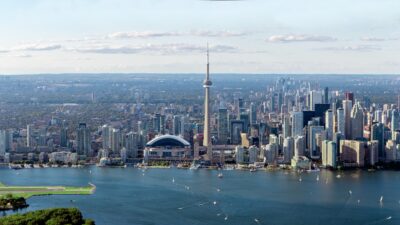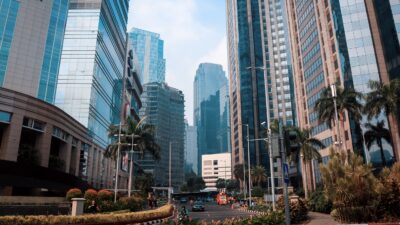
Global cities as future drivers of international business activities
It is only since 2020 that cities became home to just over half of the world’s population. But cities as an economic force are punching way above their population weight, contributing more than 80 percent of global gross domestic product (GDP).
This is due to various agglomeration and economies of scale effects leading to increased economic activity and output. Locally, urbanisation increases productivity, and boosts income and GDP per capita for city-dwellers, driving local economic activity.
Cities are the growth engine of the future, but this trend is asymmetrically distributed across the world with low-income countries experiencing skyscraper-level growth. Between 2020 and 2070, the number of cities in low-income countries will increase by 76 percent, in high-income and lower-middle-income countries by about 20 percent, and in upper and middle-income countries by 6 percent.
Global city population share doubled from 25 percent in 1950 to about 50 percent in 2020; globally we are on track for 60% urbanisation by 2030: In the developed world, consolidation will be even more intense, with an estimated 81% of the population living in cities. The majority of this will happen in Africa and Asia. In real numbers, an estimated 4.5 billion people currently live in urban areas.
But urbanisation is not only about large cities. Although Tokyo (almost 40 million people in the city proper), followed by Jakarta (35 million in larger urban area) and Delhi (30 million) are truly megacities, other types of cities also play increasingly important roles in the economic landscape. Indeed, small cities cover almost half of city land (about 45 percent) in low-income countries, a trend that will persist over the coming decades.
Bigger cities are not necessarily better
Global cities possess several characteristics that make them particularly attractive to foreign direct investments and hence global business activity. Ten years ago, our research highlighted the benefits of global cities in attracting multinational enterprise investments and location choice.
In the decade since, not only has the rate of growth of urbanisation increased but the nature and characteristics of cities have changed as well. Global cities are defined by specific attributes, which we originally identified as connectivity, cosmopolitanism, and the presence of advanced producer service firms. All of these attributes reduce the additional costs of doing business for a foreign firm in a particular location (the so-called ‘liability of foreignness’) – and this is still the case. However, the future global city offers a host of additional characteristics that may change the attractiveness of particular cities to foreign investors.
London, New York, Paris, and Sydney scored highly as cities that would be attractive to (particular types of) foreign investors, according to our 2013 ‘global-ness’ classification. Interestingly, mega-cities (10+ million people) like Delhi and Jakarta were not deemed as attractive as more globally connected smaller cities like Zurich and Madrid.
However, in the decade since, many small-to-medium sized cities have strategically positioned themselves as potential future global cities by developing new attractors, such as “smart citi-ness”, “green citi-ness”, etc. Melbourne, for instance, has moved up dramatically in the global city ranking and is now surpassing Sydney in the top 10. Moreover, while our focus in 2013 was on existing attributes that may attract foreign investments, today cities are actively pursuing agendas in collaboration with particular industries and firms to co-evolve and prosper together. For instance, world-renowned food company Fazer is planning on locating its new confectionery factory in Lahti, Finland, and has signed a cooperative agreement with the city that ensures mutual investments in sustainable and environmentally friendly infrastructure and production.
Connectivity key to attracting investment – but new connections matter
While there are many factors that makes a particular location (city) attractive to investors, they still pertain in important ways to at least two of our originally identified characteristics; namely the infrastructure of the city and its broader connectivity to other (national and international) markets. It is the capacity of a city to build and leverage its infrastructure and develop systems of connectivity that helps facilitate the other main dimensions of urban economic activity.
Connectivity will no longer be related just to airports, roads, and harbours as products and services – increasingly it will be e-based. Similarly, cosmopolitanism may take a different form, with workers located remotely and engaging with each other in different forms and fora. Advanced producer services may also still be important to access for multinational firms, however, whereas ten years ago they were more likely to be located and accessible in global cities, in the future such services are likely to be accessible almost anywhere (and instantaneously) via relatively low-cost IT platforms.
While global cities remain attractive to foreign investors and important drivers of economic development, the nature and attributes of these cities will change, and many more will likely join the club in the future.
In 2007, just 380 cities contributed half of global GDP. Researchers project that by 2030, 600 cities will account for 60 percent of global GDP.
The challenges of urbanisation
Urbanisation and the growth of cities also bring challenges. As urbanisation grows disproportionally in low-income countries, local and global policy implications emerge. Effective urban and territorial planning is critical to mitigate the negative social, economic, and environmental issues associated with urban growth. Such challenges include pressure on existing open land, infrastructure, and services leading to various crowding effects potentially harmful to both nature and humans. Policy makers in particularly low-income countries must balance the potential cost of urbanisation with the sustainability of economic growth.
Global cities will face new challenges in the future. As more cities strive to become globally connected and tap into the global infrastructure and value chains, they become increasingly dependent on the movement of goods, services, and labour across borders. Yet, as the recent pandemic has illustrated, such dependency on global connectivity for economic growth can be severely compromised in times of crisis. Human disasters such as the ongoing war in Ukraine or trade wars can also significantly reduce the economic viability of global cities.
The future resilience of global cities may hinge on their ability to build innovative and sustainable businesses that can leverage foreign capital, labour, and services without reliance on traditional cross-border transportation, logistics, and labour migration.
Professor Nielsen (with Anthony Goerzen and Christian Asmussen) won the 2023 Journal of International Business Studies (JIBS) Decade Award for the 2013 article ‘Global cities and multinational enterprise location strategy’. The award recognises the most influential article published in the journal 10 years ago.
Image: Henning Witzel
Professor Bo Bernhard Nielsen is Professor of Business Strategy at the International Business Discipline at The University of Sydney Business School. His research is at the intersection of strategy, international business, and economic geography with a specific focus on multilevel issues pertaining to strategic collaboration, firm internationalization, and strategic decision-making across borders.
Share
We believe in open and honest access to knowledge.
We use a Creative Commons Attribution NoDerivatives licence for our articles and podcasts, so you can republish them for free, online or in print.







